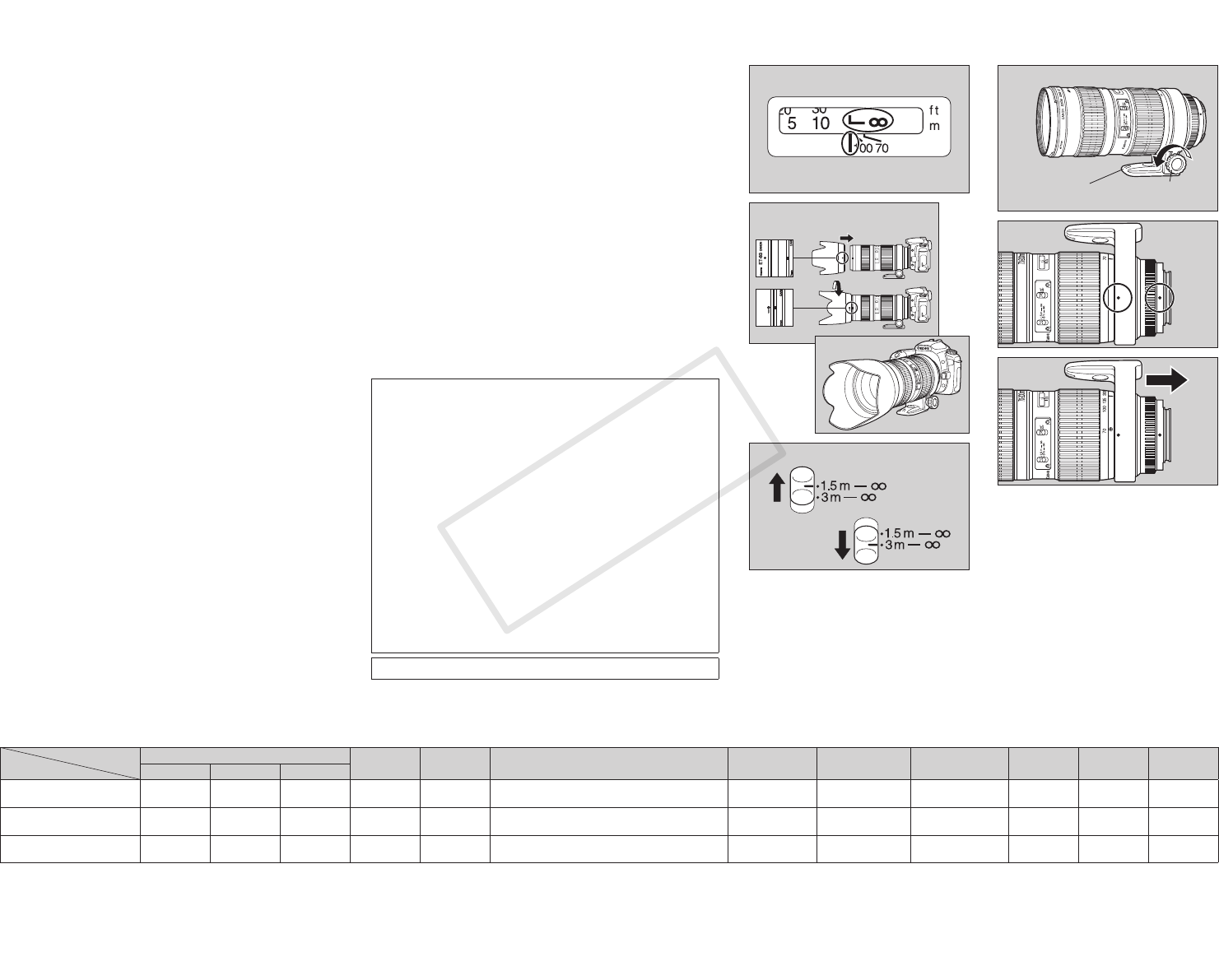CT1-8524-003 1208SZ © CANON INC. 2006
●❽
●❾
●
●
●
●❼
Tripod mount Orientation locking knob
5. Infinity Compensation Mark
To compensate for shifting of the infinity focus point that results
from changes in temperature.
The infinity position at normal temperature is the point at which the
vertical line of the L mark is aligned with the distance indicator on
the distance scale.
• ForaccuratefocusinginMFonsubjectsatinfinitydistance,look
through the viewfinder while rotating the focusing ring
❼
.
6. Hood
Toattachthehood,alignthehood’sattachmentpositionmark
withthereddotonthefrontofthelens,thenturnthehoodinthe
directionofthearrowuntilthelens’sreddotisalignedwiththe
hood’sstoppositionmark
❽
.
Thehoodcanbereverse-mountedonthelensforstorage.
• Partofthepicturemaybeblockedifthehoodisnotattached
properly.
7. Filters (Sold Separately)
You can attach filters to the filter mounting thread on the front of
the lens.
• UseapolarizingCanonfilter(77mm).
8. Switching the Focusing Distance Range (EF70-
200mm f/2.8L USM Only)
You can set the focusing distance range to 1.5 m/4.9 ft. to infinity or
3m/9.8 ft. to infinity
❾
.
• IfyouuseAFfromoutsidethespecifiedfocusingdistancerange,
the lens may stop focusing when it reaches the limit of the range.
Thisisnotamalfunction.Ifthisoccurs,presstheshutterbutton
halfway down again.
9. Extenders (Sold Separately: EF70-200mm f/2.8L USM
Only)
AFispossiblewithExtenderEF1.4×II/EF2×II.
• TheapertureFvaluesandfocallengthswhenanextenderisused
are as follows:
EF1.4×II:f/4,98-280mm,EF2×II:f/5.6,140-400mm
Attachtheextendertothelens,andthenattachthelenstothe
camera.Toremoveit,reversetheorder.Errorsmayoccurifyou
attachtheextendertothecamerafirst.
Whenyouareusinganextender,usethecenterfocusingpointfor
AF.IfyouuseAFwithadifferentfocusingpoint,afocusingerror
may occur.
10. Using the Tripod Mount (EF70-200mm f/2.8L USM
Only)
Bylooseningtheorientationlockingknobonthetripodmountyou
canrotatethecameratosettheimageforanyverticalorhorizontal
position.
Detaching the Tripod Mount
Firstremovethelensfromthecameraandthenremovethetripod
mountfromthelensasshownbelow.Toattachthetripodmount,
reverse the procedure.
1)Loosentheorientationlockingknob
.
2)Aligntheredmarkonthetripodmountwiththelensmount
index
.
3)Slideoffthetripodcollarawayfromtherearofthelens
.
n
The lens length is measured from the mount surface to the front
endofthelens.Add21.5mmtoincludetheE-77Ulenscapand
dustcap,and24.2mmfortheE-77II.
n
Thesizeandweightlistedareforthelensonly,exceptas
indicated.
n
Aperturesettingsarespecifiedonthecamera.Thecamera
automatically compensates for variations in the aperture setting
whenthecameraiszoomedinorout.
n
AlldatalistedismeasuredaccordingtoCanonstandards.
n
Productspecificationsandappearancearesubjecttochange
without notice.
This device complies with Part 15 of the FCC Rules. Operation is
subject to the following two conditions: (1) This device may not cause
harmful interference, and (2) this device must accept any interference
received, including interference that may cause undesired operation.
Do not make any changes or modifications to the equipment
unless otherwise specified in the instructions. If such changes
or modifications should be made, you could be required to stop
operation of the equipment.
This equipment has been tested and found to comply with the limits
for a class B digital device, pursuant to part 15 of the FCC Rules.
These limits are designed to provide reasonable protection against
harmful interference in a residential installation. This equipment
generates, uses and can radiate radio frequency energy and, if not
installed and used in accordance with the instructions, may cause
harmful interference to radio communications.
However, there is no guarantee that interference will not occur
in a particular installation. If this equipment does cause harmful
interference to radio or television reception, which can be determined
by turning the equipment off and on, the user is encouraged to try to
correct the interference by one or more of the following measures:
• Reorientorrelocatethereceivingantenna.
• Increasetheseparationbetweentheequipmentandreceiver.
• Consultthedealeroranexperiencedradio/TVtechnicianforhelp.
This Class B digital apparatus complies with Canadian ICES-003.
Specifications
Angle of view
Lens
construction
Minimum
aperture
Max.magnificationandfieldofview
Min. focusing
distance
Filter diameter
<Usable number>
Max.diameter
and length
Weight Hood Case
Diagonal Vertical Horizontal
EF17-35mmf/2.8LUSM 104°-63° 70°30’-38° 93°-54° 10-15 22
0.06 -0.11× 432 × 671 mm -214 × 320 mm
(17” × 26.4”-8.4” × 12.6”)
0.42 m 77 mm <1>
83.5 × 95.7 mm
(3.3” × 3.8”)
545 g
(19.1 oz)
EW-83 CII LP1216
EF28-70mmf/2.8LUSM 75°-34° 46°-19°30’ 65°-29° 11-16 22
0.08 -0.18× 298 × 452 mm -133 × 198 mm
(11.7” × 17.8”-5.2” × 7.8”)
0.5 m 77 mm <1>
83.2 × 117.6 mm
(3.3” × 4.6”)
880 g
(30.8 oz)
EW-83 BII LP1219
EF70-200mmf/2.8LUSM 34°-12° 19°30’-7° 29°-10° 15-18 32
0.06 -0.16× 409 × 617 mm -152 × 226 mm
(16.1” × 24.3”-6” × 8.9”)
1.5 m 77 mm <1>
84.6 × 193.6 mm
(3.3” × 7.6”)
1,310 g
(45.9 oz)
ET-83II LZ1324


















